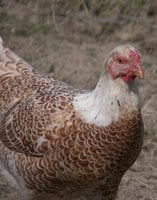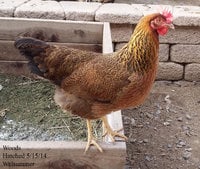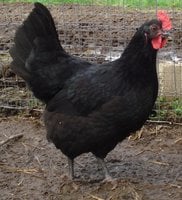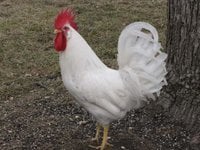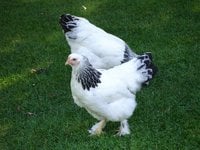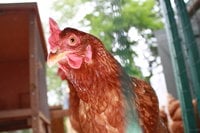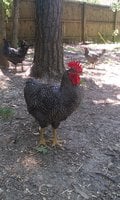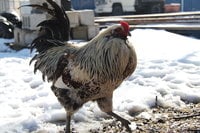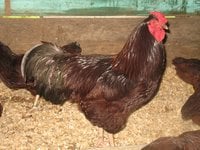Dark Cornish have been a great addition to our backyard flock. All of them eagerly rustle their own food, foraging widely through brush and field, spending little time at the feeder. Birds are broad backed, with their sturdy legs widely spaced. Comb and wattle development is minimal, which may cost it some ability to dissipate heat in the summer, but by the same token, will reduce heat losses and vulnerability to frost bite in winter. The overall appearance of these birds, especially the males, is more of a wild-type bird, with a bold eye, strong brows, tight-fitting, glossy feathers, and a more stout beak than most domestic fowl. Despite this rather tough looking face, these birds are docile, quiet, and accept human handling fairly well. The tight feathering makes the bird look smaller than it is...mine weigh as much or more than the Rocks and RIR's in the same flock, but at first glance, they look more compact. They seem to be more intelligent than the average chicken, learning a new routine or accepting training well.
Crossing this bird with the Plymouth Rock breeds produces a fast-growing meat bird that is excellent table fare. This cross is the same one used in the broiler industry, but don't expect your home crosses to grow as fast as commercially produced cornish rocks---those are produced by breeding companies investing fortunes selecting sire and dam lines and producing their final cross. We have our Dark Cornish running with White Rocks and Welsummers and some crossbred hens, and we are getting some VERY robust chicks this year!
Hens came into lay around 20 weeks, comparable to other heavy breeds. Egg production is acceptable, with hens laying a medium sized, firm-shelled brown egg. Hens eagerly go broody, successfully setting even large clutches of eggs and raising chicks very well. Egg production levels are not going to compare to traditional brown egg layers such as the Rhode Island Red or Plymouth Rocks, but when you add in the contribution this bird can make toward meat bird genetics, plus the chicks the hens will raise for you, they are definitely a worthy addition to the flock.
Note: I edited the original breed description that was listed. It stated that the birds were vulnerable to cold, are poor layers, and that the tight feathers make it hard for a hen to cover many eggs. These statements are simply not born out by the realities of raising this breed. I have seen no sign they are having more trouble with the cold than other birds...to the contrary, in fact. Egg production is moderate, not poor, with production maybe 140-180 eggs per year (a Maran or Rock will give you 200+, a leghorn 250+). When you consider that a chunk of that year was spent setting and brooding rather than laying, this production is not so bad. And my hens have hatched 10 of 11 eggs, 8 of 10 eggs, 7 of 8 eggs, and 3 of 10 eggs this year (that last one, hatch rate was low because I put a thin-shelled egg from an older bird in the nest, it broke, and yolks covered most of the eggs). Keep in mind that these eggs are hand-selected to be the larger eggs (selecting for egg size), so these hens are successfully setting 10-12 large -xl eggs. This is as good a hatch rate as any hens we have had, and these hens are absolutey dedicated mothers.
Overall ths is an excellent breed. I will always keep their genetics in my flocks!
Crossing this bird with the Plymouth Rock breeds produces a fast-growing meat bird that is excellent table fare. This cross is the same one used in the broiler industry, but don't expect your home crosses to grow as fast as commercially produced cornish rocks---those are produced by breeding companies investing fortunes selecting sire and dam lines and producing their final cross. We have our Dark Cornish running with White Rocks and Welsummers and some crossbred hens, and we are getting some VERY robust chicks this year!
Hens came into lay around 20 weeks, comparable to other heavy breeds. Egg production is acceptable, with hens laying a medium sized, firm-shelled brown egg. Hens eagerly go broody, successfully setting even large clutches of eggs and raising chicks very well. Egg production levels are not going to compare to traditional brown egg layers such as the Rhode Island Red or Plymouth Rocks, but when you add in the contribution this bird can make toward meat bird genetics, plus the chicks the hens will raise for you, they are definitely a worthy addition to the flock.
Note: I edited the original breed description that was listed. It stated that the birds were vulnerable to cold, are poor layers, and that the tight feathers make it hard for a hen to cover many eggs. These statements are simply not born out by the realities of raising this breed. I have seen no sign they are having more trouble with the cold than other birds...to the contrary, in fact. Egg production is moderate, not poor, with production maybe 140-180 eggs per year (a Maran or Rock will give you 200+, a leghorn 250+). When you consider that a chunk of that year was spent setting and brooding rather than laying, this production is not so bad. And my hens have hatched 10 of 11 eggs, 8 of 10 eggs, 7 of 8 eggs, and 3 of 10 eggs this year (that last one, hatch rate was low because I put a thin-shelled egg from an older bird in the nest, it broke, and yolks covered most of the eggs). Keep in mind that these eggs are hand-selected to be the larger eggs (selecting for egg size), so these hens are successfully setting 10-12 large -xl eggs. This is as good a hatch rate as any hens we have had, and these hens are absolutey dedicated mothers.
Overall ths is an excellent breed. I will always keep their genetics in my flocks!

